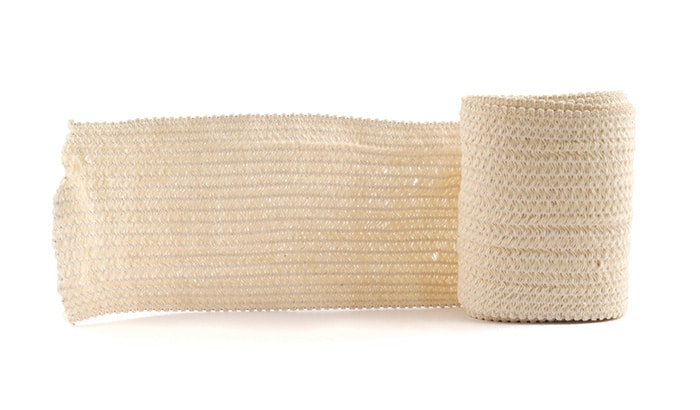When you think of first-aid items, do compression bandages come to mind? You might think of things like bandaids, alcohol prep wipes, Neosporin, and traditional bandages before you think about using compression bandages. Still, it’s essential to know about the latter if you want to be prepared for any situation.
Compression bandages are a great way to reduce swelling, fluid accumulation, and pain. A common first-aid item, these bandages are great for individuals who suffer from the following injuries and conditions:
- Sprains to the ankles and wrists: sprains can cause swelling, and compression bandages can reduce the swelling and boost the healing process.
- Blood flow problems: Individuals who suffer from poor circulation find that their bodies can’t move blood back to the heart from the limbs. Compression wraps can help improve blood flow to the heart.
- Issues with veins and the lymphatic system: Compression bandages can treat things like varicose veins and venous leg ulcers. Compression wraps pressure surface veins, forcing blood back into the deep vein system.
- Lymphoedema: This condition affects a person’s circulatory system. Compression bandages can help a person manage symptoms and ease the swelling or distortion of their skin.
This type of bandage applies pressure on the injured area but should only be used for a few days and for minor injuries. When alternated with RICE therapy (Rest, Ice, Compression, and Elevation), an individual can expect a smooth and hopefully quick recovery.
Compression bandages can also help with circulation issues — think about compression socks.
What to Avoid When Wearing Compression Bandages
Of course, as with anything, there are some things that you should avoid doing when wearing a compression bandage.
- Avoid using the RICE method while wearing compression bandages. You should do these two forms of first-aid in alternation to prevent frostbite.
- Avoid applying the bandage too tightly; this can cut off blood flow. Check to see if you begin to feel numbness in your toes or fingers and if your limbs begin to turn purple/blue — if they do, you need to loosen the bandage.
- Compression bandages do not prevent injury and should not be used as a protective accessory.
- Avoid wearing the bandage while you sleep.
- Remember that the bandage does not provide support. In most cases, you will probably need a brace in conjunction with the bandage.
Compression bandages are helpful for injuries, but they can also make an injury worse if misused.
Compression Bandages Come in Sizes
While there are bandages that can serve as a one-size-fits-all solution, compression bandages come in different sizes. These bandages can range anywhere from two to six inches, and knowing what you can use each size for is vital to injury recovery.
Here are some situations in which you may use different bandage sizes:
- You can use six-inch compression bandages for chest, torso, and thigh injuries.
- You can use three to four-inch bandages for adult limbs, such as an arm or leg.
- Two-inch bandages are better used for children’s limbs and adult fingers.
Wider bandages are more likely to cut circulation. You should make sure that you use the proper bandage for each situation to prevent further injury.
How to Apply Compression Bandages
Compression bandages are meant to apply pressure to the injury, but one must make sure to find the perfect amount. Additionally, wrapping injured joints can be far more complex than covering a thigh.
When wrapping a limb, you must do the following:
- Make sure the bandage is rolled up.
- Hold the bandage so that the start of the roll is facing upward.
- Keep the limb in a neutral position.
- Wrap the furthest end of the limb.
- Continue to wrap while overlapping the edges of the bandage by about an inch every time you go around.
- Secure the end of the bandage with clip fasteners or tape.
When wrapping an ankle, one must do the following:
- Make sure the bandage is rolled up.
- Hold the bandage so that the start of the roll is facing upward.
- Keep their ankle at a 90-degree angle.
- Begin wrapping near the ball of the foot and wrap the bandage several times, continuing until they reach the heel.
- Leave the heel exposed and circle the bandage around the ankle.
- Circle the bandage in a figure-eight pattern around the arch of the foot.
- Continue wrapping the bandage in a figure-eight pattern. Move down toward the heel on the bottom and up toward the top of the calf.
- The wrap should cover the entire foot, starting at the base of the toes to about five or six inches above the ankle.
- Secure the with clip fasteners or tape.
Wrapping a wrist with compression bandages requires a somewhat different approach:
- Make sure the bandage is rolled up.
- Hold the bandage so that the start of the roll is facing upward.
- Begin at the base of the fingers. Wrap the bandage around the hand between the thumb and index finger.
- Continue wrapping around the hand and move toward the wrist, making sure to overlap the bandage.
- Circle the wrist several times and end about five to six inches above it.
- Secure the end with clip fasteners or tape.
During any of these situations, the bandage should feel snug without causing pain, discomfort, numbness, tingling, or causing the toes and fingers to feel cold. Additionally, blue or purple discoloration indicates that the bandage has been wrapped too tight and needs to be reapplied.
Get the Medical Supplies You Need from Allied USA
If you’re looking for a reliable vendor for essential medical supplies like compression bandages, get in touch with us at Allied USA. We’re determined to bring you and your practice the highest quality service and products for your clients.
Call us at 855.597.4733 or fill out our contact form to request a free quote!

